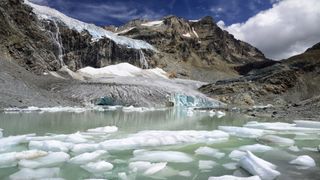I doubt that very much, if Rat is there it has to be associated with global warming.
Will we have more earthquakes because of climate change?
News
By Katherine Irving
published July 9, 2024
Changes in sea level and glacial melt could make earthquakes more likely in the coming years.

An earthquake tore the asphalt apart in a parking lot in Trona, California, in early July 2019. (Image credit: MLGXYZ via Getty Images)
Earthquakes are one of the most mysterious and terrifying natural disasters. Although we have some idea of when the big ones might happen, others can occur seemingly out of nowhere, bulldozing cities and creating secondary disasters such as fires, landslides and tsunamis. Climate change is causing increases in other natural disasters, like wildfires and hurricanes. So could it make earthquakes more common, too?
The biggest and most dangerous type of earthquake is the tectonic earthquake. These earthquakes occur because of tectonic plates, the massive slabs of rock that make up Earth's crust and upper mantle. Heat emanating from deep within the planet causes these plates to move an average of half an inch (1.5 centimeters) per year, making them rub up against each other. The pressure in those areas builds until it reaches a breaking point where the plates will move suddenly, releasing energy that causes earthquakes.
Unlike with other disasters, it's almost impossible to predict when earthquakes will happen, making planned evacuations next to impossible.
Unfortunately, climate change could make quakes happen closer together and with more intensity, experts told Live Science. With global warming, glaciers are melting at an increased rate. When melted glacier water flows off land and into the sea, the land that used to sit underneath it rises, said John Cassidy, an earthquake seismologist at the Geological Survey of Canada and the University of Victoria.
It's the same principle as when a child pushes a pool noodle below the surface and then lets go: The noodle stays down as long as there's pressure from above, but as soon as that pressure is released, it rises back up. When this happens, pressure differences can cause faults that previously lay dormant to suddenly go off, causing earthquakes, Cassidy told Live Science.
Related: How big is the largest possible earthquake?

A glacier in Switzerland melts into a lake. Glacial melt could cause more earthquakes in the coming years. (Image credit: Andrea Toffaletti / 500px via Getty Images)More concerning than glacial-melt earthquakes are those that could be caused by an increase in sea level. As sea levels rise, pressure underwater on the seafloor also goes up, said Marco Bohnhoff, a geophysicist at GFZ Helmholtz Centre Potsdam and Free University Berlin in Germany. As water pressure spikes, the pressure on fault lines near the coast will also increase.
Sign up for the Live Science daily newsletter nowGet the world’s most fascinating discoveries delivered straight to your inbox.
Contact me with news and offers from other Future brandsReceive email from us on behalf of our trusted partners or sponsorsBy submitting your information you agree to the Terms & Conditions and Privacy Policy and are aged 16 or over.
"Several earthquakes are late in their seismic cycle," Bohnhoff told Live Science, including earthquakes predicted to happen near San Francisco and Los Angeles in the next few decades. "That means just a little increase in pressure is enough to advance the seismic clock. It might be enough in many places to trigger earthquakes."
Even if we stopped using greenhouse gases now, it would take up to 1,000 years for sea level rise to stop, Bohnhoff added. He predicts that over that time, the gaps between big coastal earthquakes will become shorter.
Because proving this prediction would take centuries, Bohnhoff's research is based mostly off of existing models. For example, scientists modeled increases and decreases in the water level of the Salton Sea, an inland body of water about 80 miles (130 kilometers) northeast of San Diego, over the past 1,000 years, and found that when the lake was full, more earthquakes happened along the nearby San Andreas fault.
RELATED MYSTERIES
— What are the deepest spots in Earth's oceans?
— Can solar storms cause tsunamis?
— Why do earthquakes happen far away from plate boundaries?
Cassidy, however, is uncertain whether sea level rise would cause enough of a pressure change to make these giant quakes happen faster, at least within our lifetimes. He emphasized that when they do happen, climate change will make them more dangerous. Tsunamis triggered by earthquakes will reach farther inland as the sea level rises. Warmer oceans will lead to increased rainfall, which will raise the risk of earthquake-induced landslides. Rainfall will also make earthquake shaking more pronounced, since any vibration in wet ground is far more amplified than in dry ground. But again, we won't know exactly what will happen until it happens, and according to Cassidy there's still a lot we have to figure out.
"It's an important topic, and one that I'm sure we'll see a lot of information coming out on in the coming months and years," he said. "But no matter what we've discovered, it's not good news." |




